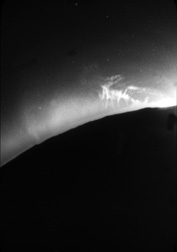By: James H. Capshew, University Historian
Excitement is building for viewing the solar eclipse in America on August 21, 2017. The path of totality passes to our south, but Bloomington will get a good taste of the temporary darkness during the day with over 90% of the sun’s disk covered. This dramatic natural phenomenon continues to fascinate astronomers and the public alike, connecting us to our atavistic roots.
Astronomers at Indiana University have long maintained an interest in observing solar eclipses. Although IU has not been a major center for solar research, eclipse observation has been a regular feature of astronomy pedagogy as well as a public spectacle.
In 1869, on August 7th, professor of natural science Theophilus Wylie organized a solar eclipse viewing on the roof of his residence. He lived in the Wylie House, built in 1835 by his cousin, Andrew Wylie, the first IU president (1828-51).

Among the observers were mathematics and astronomy professor Daniel Kirkwood and Greek professor Elisha Ballantine. Although Wylie and his assistant made preparations to photograph the eclipse by attaching a camera to his telescope, “but when the totality came on, we both broke and ran to see it, and let the important moment pass.” In his daily diary, Wylie recorded: “witnessed the total eclipse of the sun, a most magnificent sight.
The corona splendid, radiated, extending on an average ¼ diam. of the moon’s disk, all around. . . . there were tufts of flame shining with brilliancy. . . . The birds flitted about alarmed. The cocks crowed. Noticed a bat flying about. The whole landscape had an unearthly unnatural aspect.”
Eclipses have also inspired IU faculty and students to travel to distant locations. In 1905, IU astronomers mounted an expedition to Almazán, Spain, to observe the solar eclipse on August 30th. John A. Miller, Professor of Mechanics and Astronomy, and Wilber A. Cogshall, Assistant Professor of Astronomy, were accompanied by three students, including E.C. Slipher (who became a noted astronomer at Lowell Observatory).
They spent nearly a month on site preparing several cameras for photographic observations. On the day of the eclipse, the weather was cloudy and interfered with the images. Nonetheless, Miller enthused: “The indescribable deep blue of the great clouds, bordered with what anyone but an eclipse observer would call a silver lining, was totally unlike anything I have ever seen, and was strikingly beautiful.”
In 1918, Professor Cogshall joined again with John Miller, who had moved to Swarthmore College, on the William G. Sproul Eclipse Expedition to Brandon, Colorado, for the June 8th celestial event. At the eastern Colorado site for about a month before the eclipse, the small party of astronomers and assistants was augmented by several citizens of Brandon who aided in the observations the day of the eclipse.

Lieutenant Lawrence Wheeler, a student who had been on leave from IU to serve in the armed forces during the First World War, joined the expedition midway. (Wheeler later became the first executive director of the IU Foundation, from 1944-49.) Miller reported that the eclipsed sun “was an extremely beautiful one. There were three huge prominences that were easily visible to the naked eye.”
Professor Cogshall traveled to Conway, New Hampshire, to observe the August 31, 1932 solar eclipse. Back at the IU campus, where 80% of the sun’s disk was covered, the eclipse made “a lasting impression” on Frank Edmondson, a rising senior. He graduated in 1933, obtained a PhD in astronomy at Harvard University in 1937, and then returned to IU as professor of astronomy for a long career.
He made noteworthy contributions to the study of asteroids, a field that his 19th-century predecessor, mathematical astronomer Daniel Kirkwood, pioneered in positing “Kirkwood gaps” in the asteroid belt. After his retirement in the 1980s, Edmondson endowed the Daniel Kirkwood Chair in Astronomy at Indiana University.
The current Kirkwood professor, Catherine Pilachowski, rescued a battered sign from the basement of Kirkwood Observatory announcing the “Indiana Univ. Eclipse Station,” dated August 31, 1932. Now hanging in her campus office, the sign calls up the intriguing interconnections of IU astronomy faculty and students with one of nature’s most amazing celestial events.
We don’t know whether this solar eclipse will inspire a student’s career in astronomy, but Monday’s event will become part of IU’s future history.
Read more about IU’s eclipse history here: IU Eclipse History-2ed1ear
*Thanks to Sarah Reynolds and Catherine Pilachowski for assistance.
Selected Sources
Theophilus A. Wylie diary, entry August 8, 1869; Indiana University Archives.
John A. Miller, “Observations of the Total Solar Eclipse of August 30th, 1905,” Proceedings of the Indiana Academy of Science, 1905, 15, 71-80.
John A. Miller, “The William G. Sproul Eclipse Expedition,” Popular Astronomy, 1918, 26, 481-483.
Catherine A. Pilachowski, Margaret K. Edmondson Olson, and Frank K. Edmondson, Jr., “Obituary: Frank K. Edmondson (1912-2008),” Bulletin of the American Astronomical Society, 2009, 41, 1202-04.